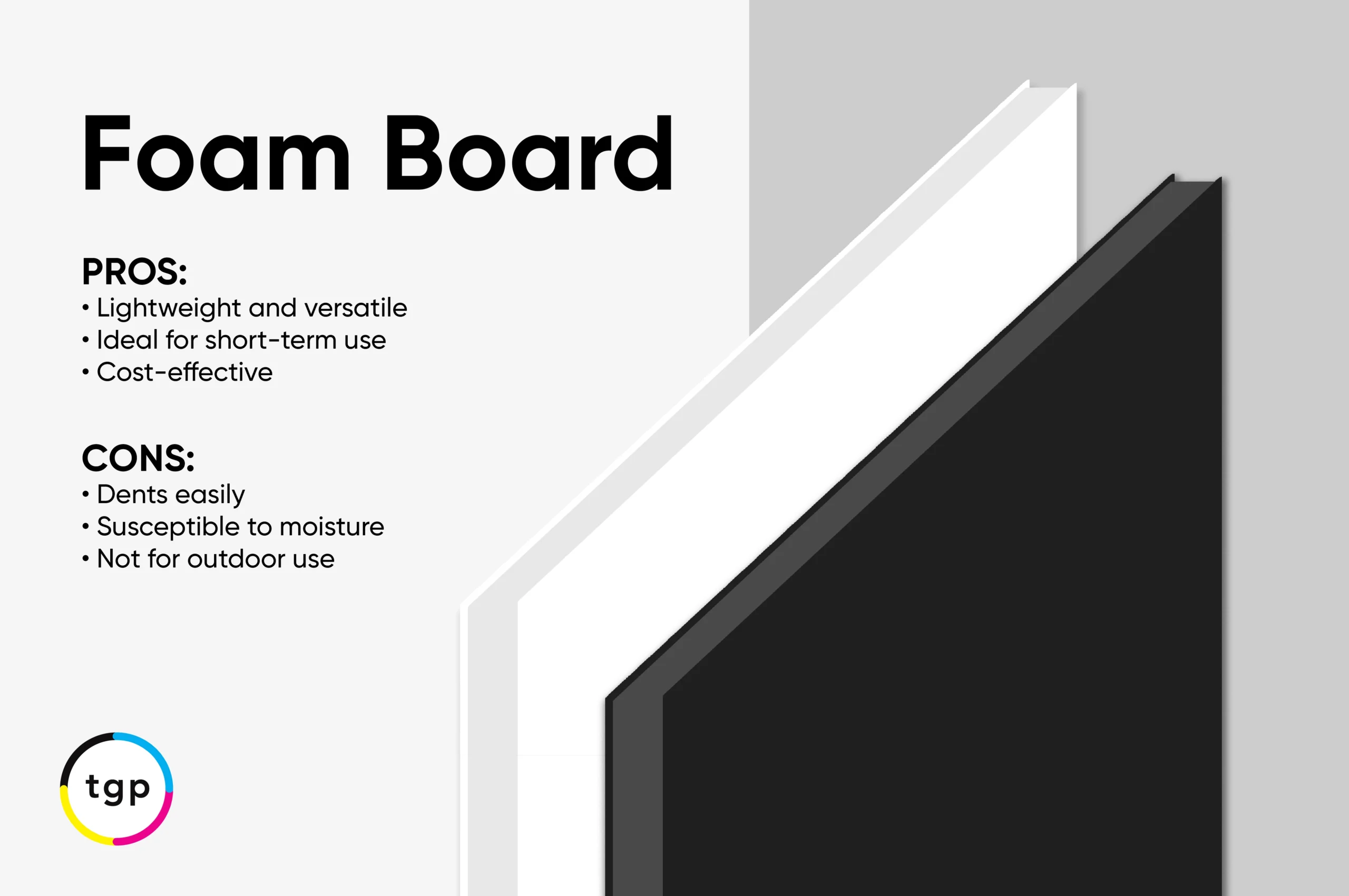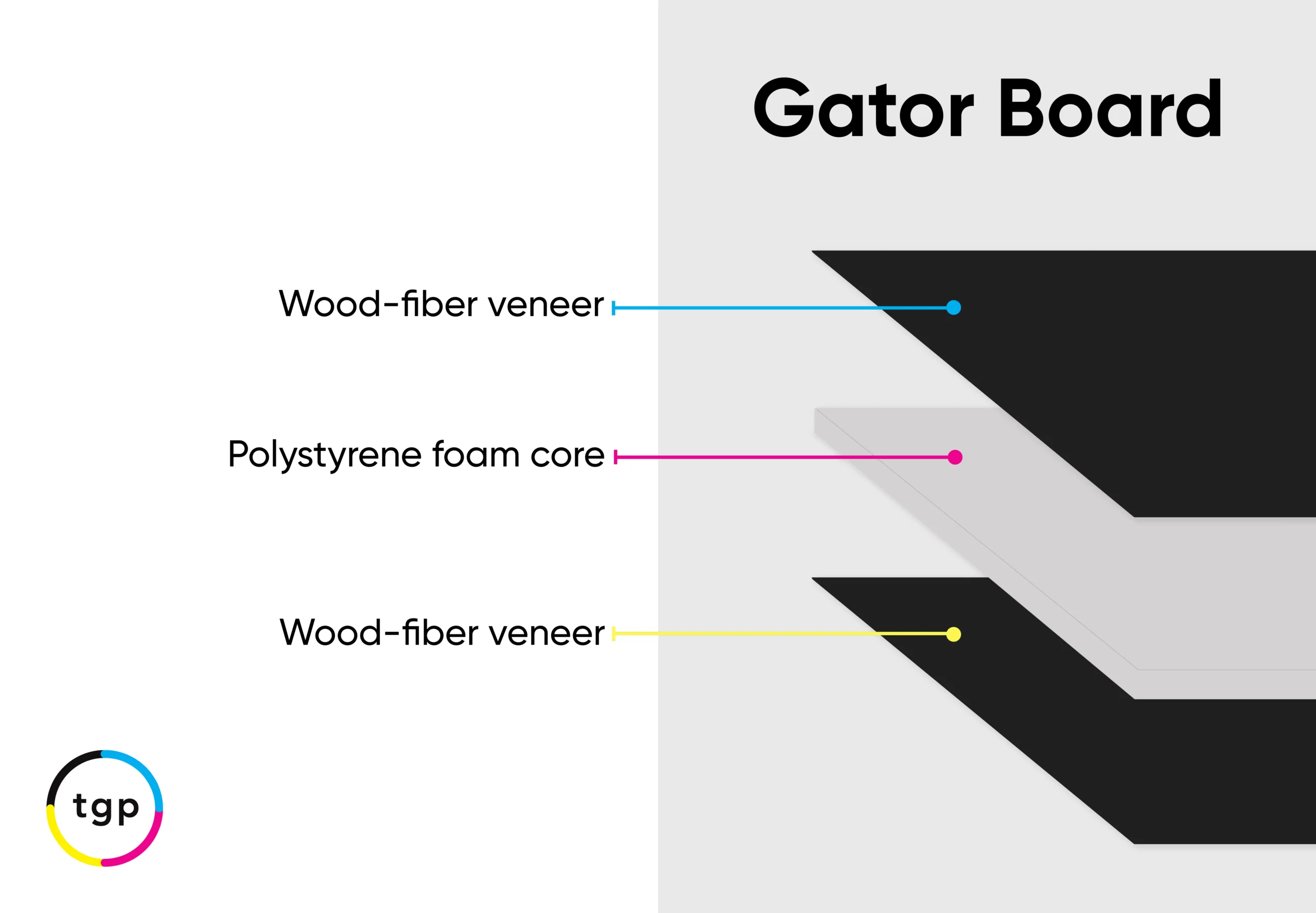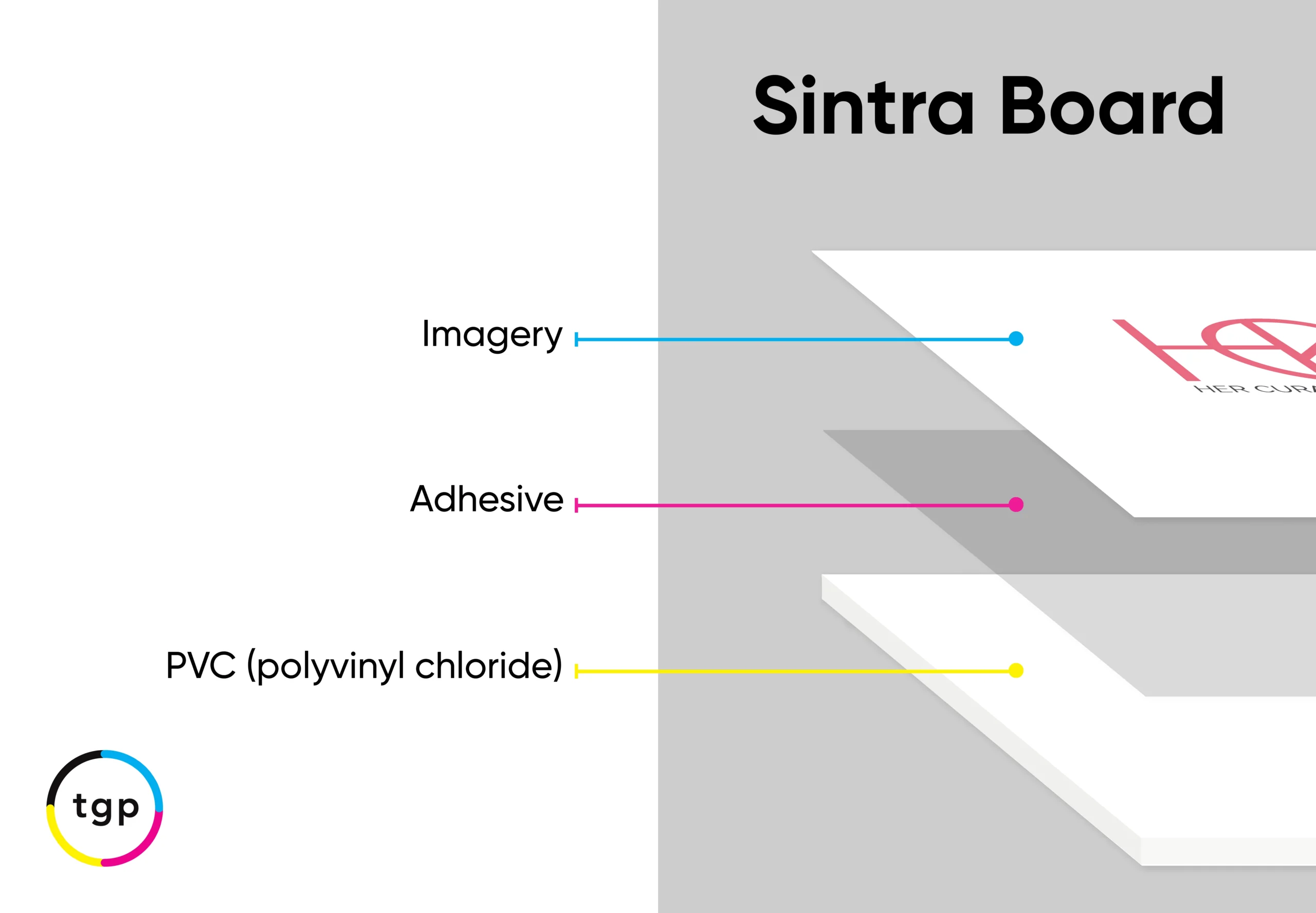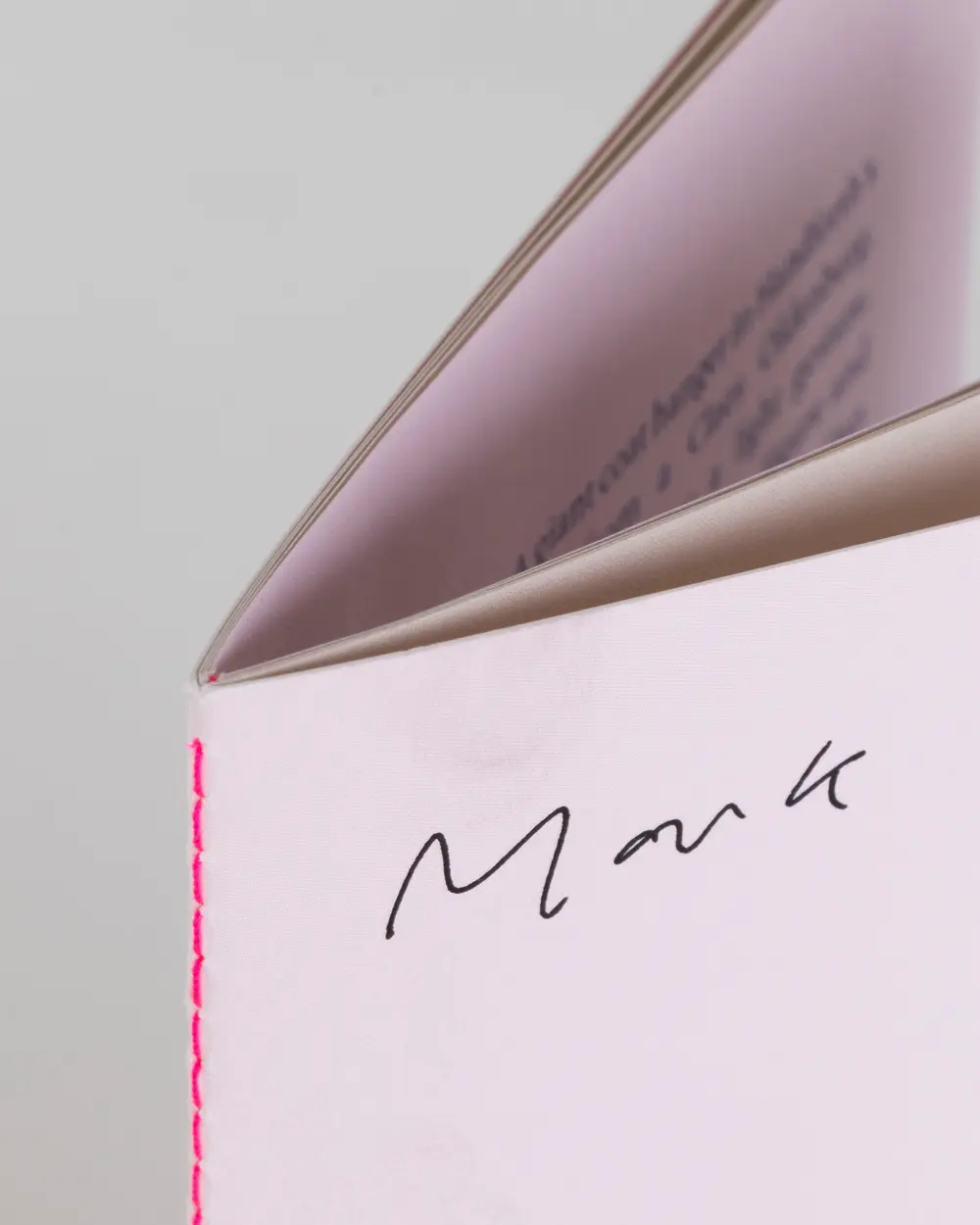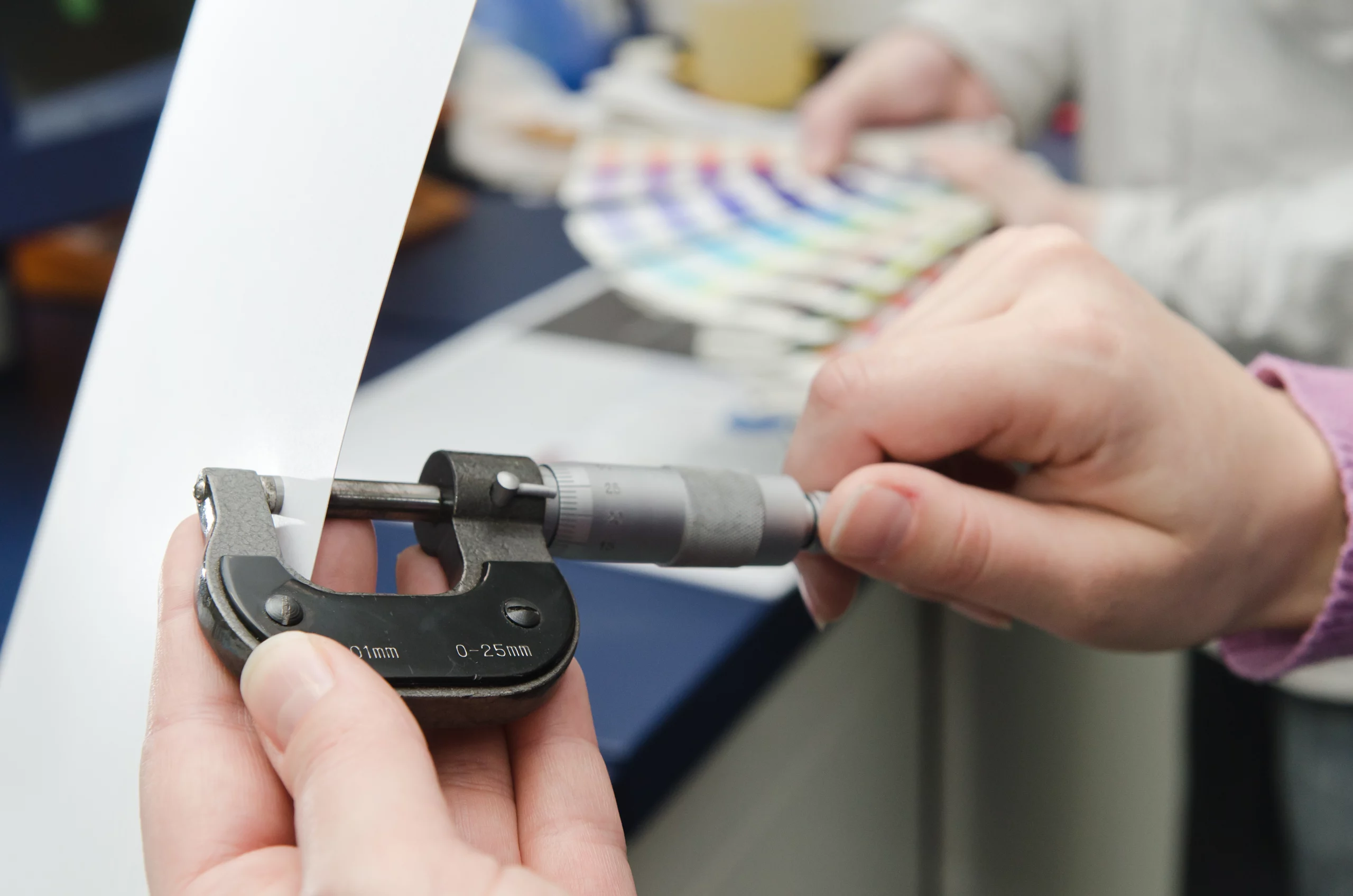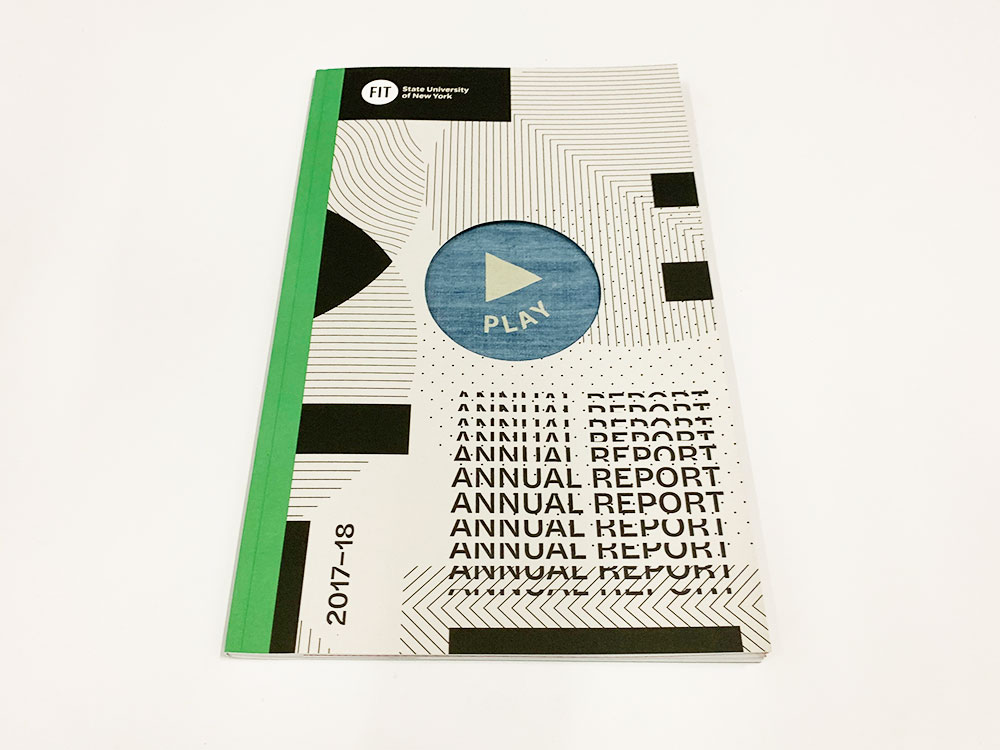When it comes to display projects, every choice matters – and the type of foam board you select is no exception. The right material not only defines the look of your project, it impacts its durability and longevity. Understanding the differences between Foam Board, Gator Board, and Sintra Board is essential.
Each has its strengths, suited to different environments and uses: from lightweight and budget-friendly to weatherproof and ultra-durable. Making the right choice can feel like a challenge – but that’s where we come in.
At Thomas Group Printing, we’re committed to helping you find the perfect solution for your specific needs. We’ll take the guesswork out of the decision-making process by breaking down the features and benefits of each foam board type. You’ll have all the information you need to confidently select the material that brings your vision to life.
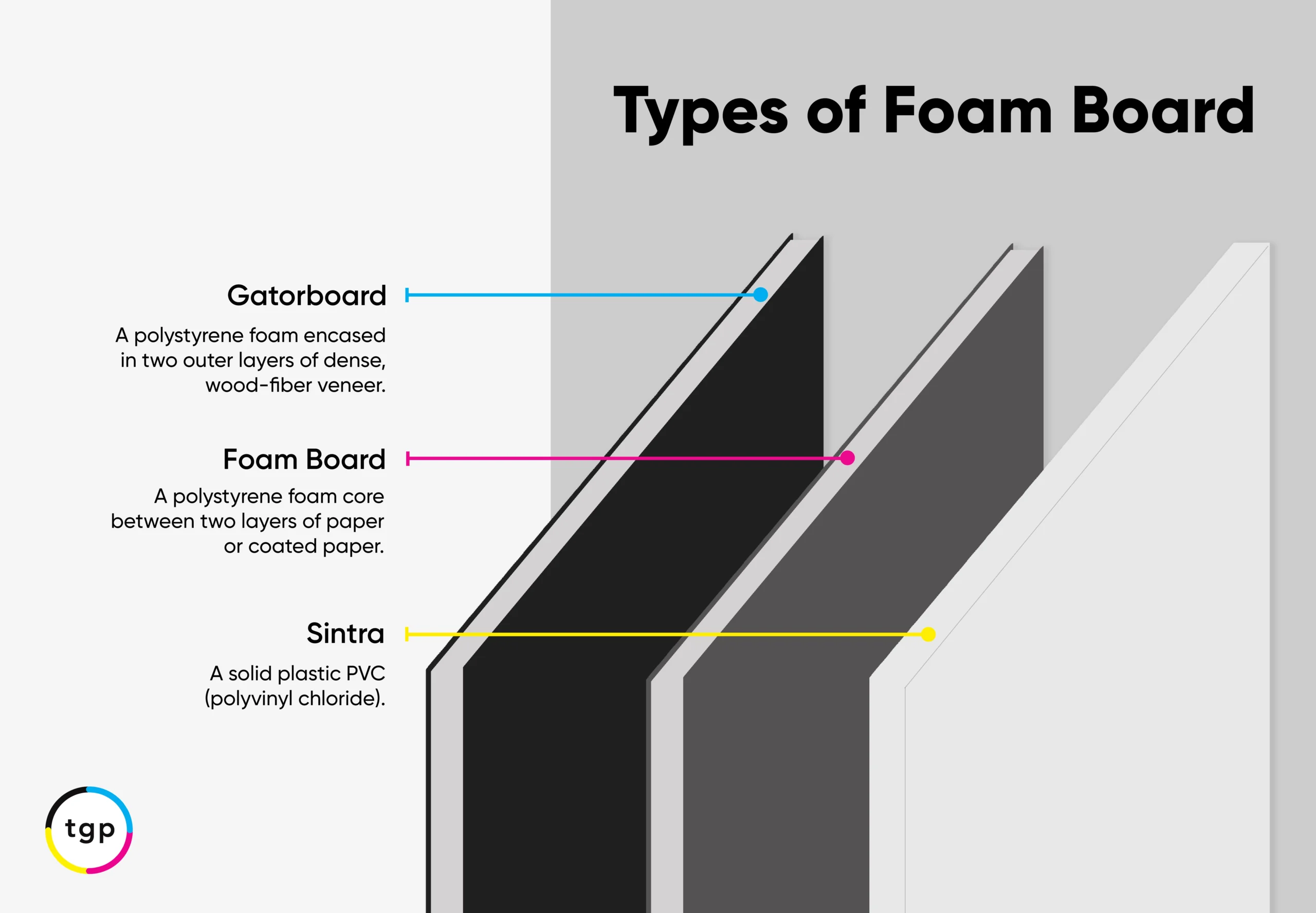
What Are The Different Types Of Foam Boards?
When it comes to foam board, there are several options available, each designed to suit different priorities. Understanding the key differences will help you choose the right type for your project. The most common options include:
- Foam Board (Foam Core) is known for its lightweight construction and smooth surface.
- Gator Board is a more durable option than standard foam board.
- Sintra Board, made from solid PVC, is much more durable than traditional foam board options and is great for outdoor use.
Types Of Foam Board Materials Chart
The different types of foam boards can often be confusing due to their similar appearances. However, each type has distinct characteristics that set it apart.
Knowing these differences will help you choose the right material for your project.
| Type of Board | Weight | Durability | Exterior | Finish | Suitable for Outdoor Use |
| Sintra Board | Light | 5/5 | PVC | Low gloss | Yes |
| Gator Board | Very Light | 3/5 | Wood Veneer | Glossy | Short Term |
| Foam Board | Lightest | 2/5 | Paper | Matte | No |
Gator Board Vs Foam Board Vs Sintra Board
When it comes to selecting the best material for your signage, understanding the differences between Foam Board, Gator Board, and Sintra Board will help you make the best choice. Each material has unique properties that make it, making them the best choice for specific uses.
For short-term projects on a budget, foam board is a great option because it’s affordable and easy to work with.
For projects that demand durability and longevity, Gator Board is recommended for indoor use, while Sintra Board is ideal for outdoor use.
Each material has strengths, and your choice depends on factors like outdoor durability, budget, or print quality.
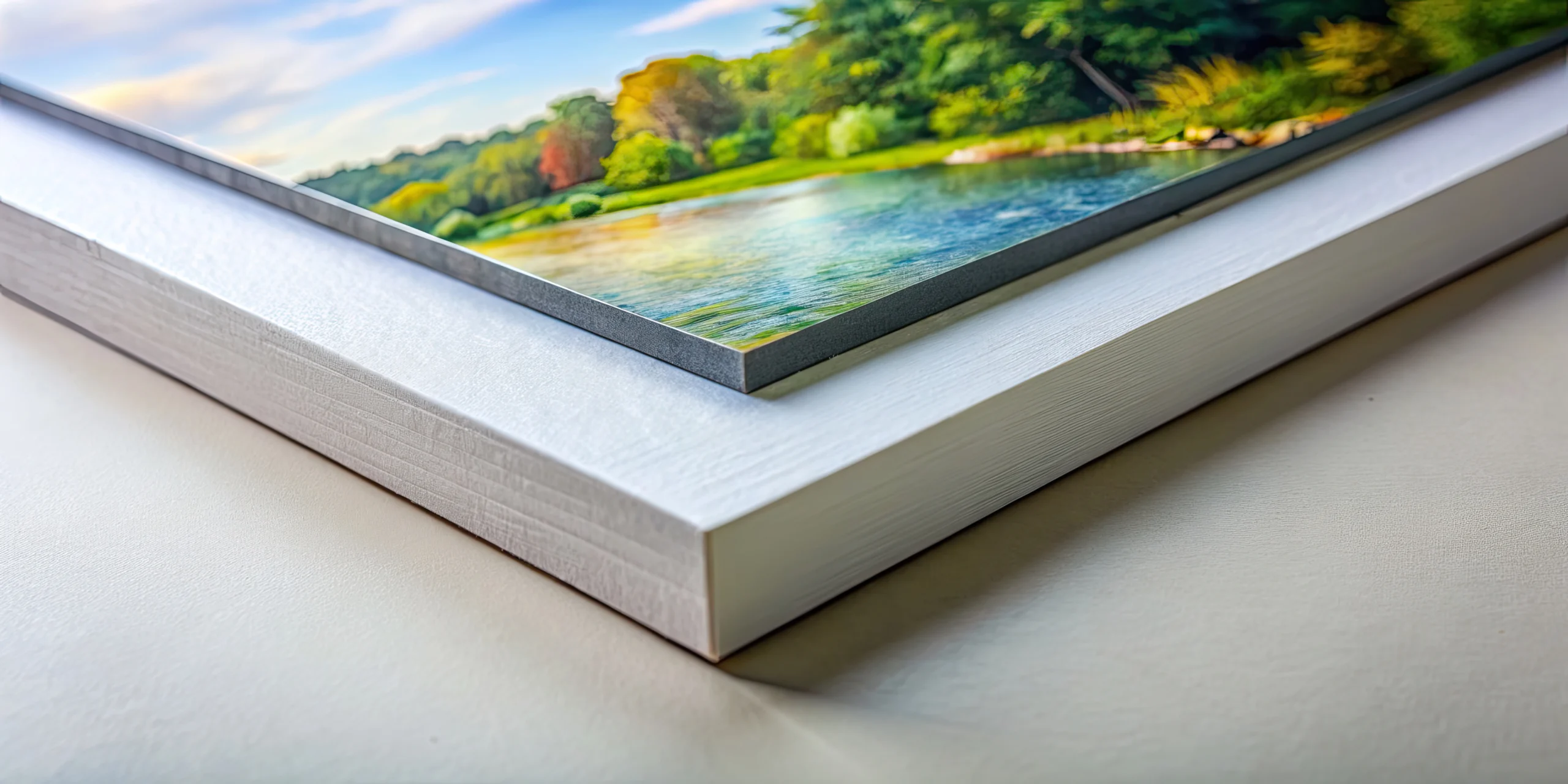
What is Foam Board?
Foam Board, sometimes called Foam Core, is a go-to material in the printing and design world, known for its lightweight and versatile nature. We often recommend Foam Board for projects like mounting prints, creating displays, or producing signs that require a smooth, clean surface. Its affordability makes it ideal for short-term use, like presentations, events, or temporary signage.
However, while Foam Board offers great value, it’s best for indoor use because it dents easily and is susceptible to moisture. For designers and businesses looking for a cost-effective solution that doesn’t compromise on quality, Foam Board is a reliable choice.
What Is Foam Board Made Of?
Foam Board is composed of three main layers. The core is made from polystyrene foam, a lightweight yet sturdy material that provides structure and rigidity. This foam core is sandwiched between two outer layers of paper or coated paper.
These outer layers give Foam Board its smooth, flat surface, and its signature rigidity while keeping it easy to handle and maneuver. It’s no surprise that foam board is a popular choice for a wide range of uses, from professional wayfinding to art displays.
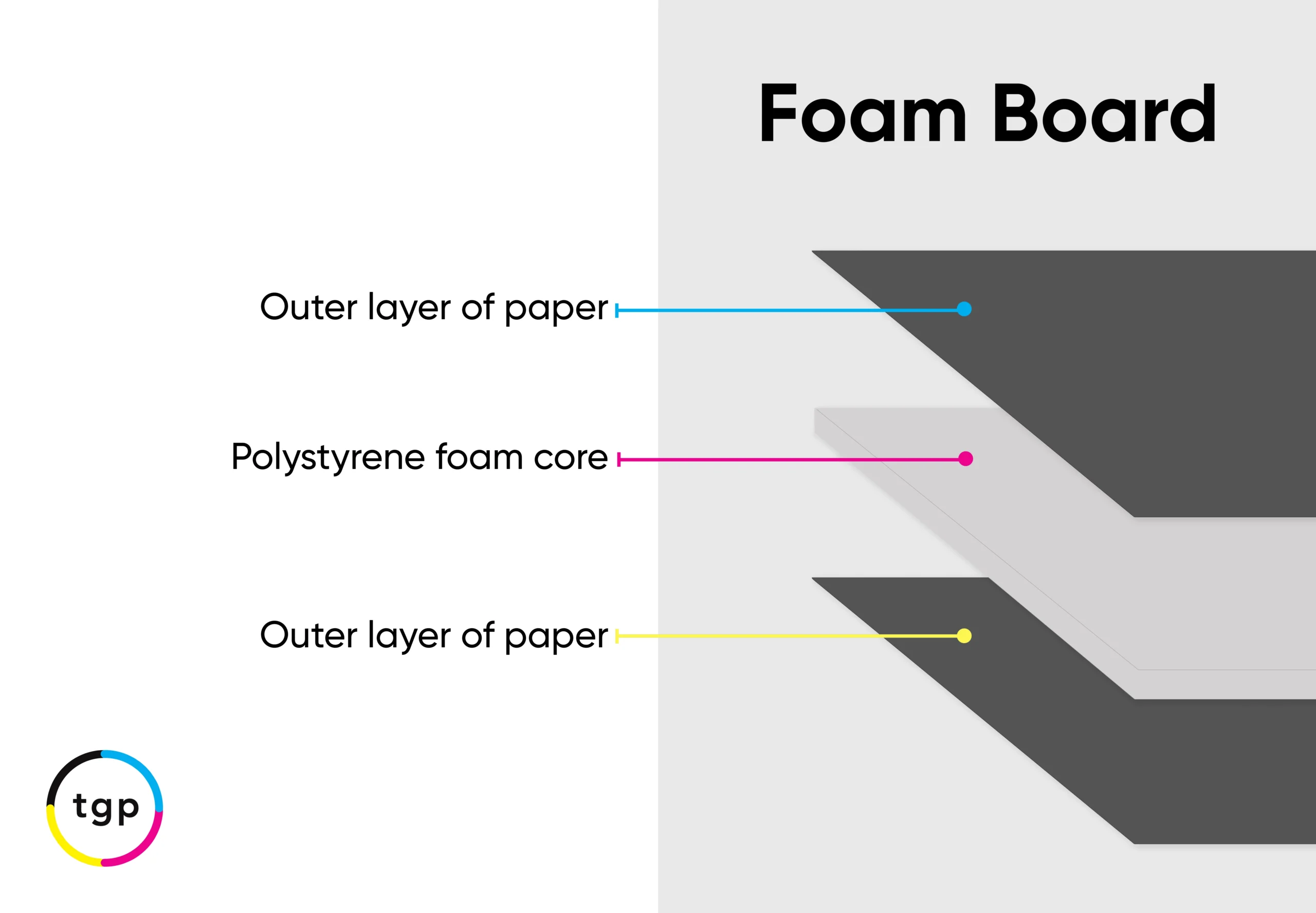
Common Uses For Foam Core Board Printing
Foam Board is a popular choice in the commercial printing industry due to its lightweight, durable, and versatile nature. Here are some of the most common uses for commercially printed Foam Board:
- Retail Signage: Eye-catching in-store signs, promotional displays, and sale notifications.
- Event Signage and Displays: Temporary, high-quality signs for conferences, trade shows, and other short-term events.
- Point-of-Purchase (POP) Displays: Lightweight displays that highlight featured products or promotions in retail settings.
- Mounted Posters and Prints: A smooth, sturdy backing that elevates the impact of prints.
- Directional Signage: Great for creating internal wayfinding signs in large commercial spaces like malls, offices, and event venues.
What Is Gator Board?
Gator Board is a durable and professional-grade material commonly used in the printing and display industries. It’s known for its strength and rigidity, making it a preferred choice for mounting, signage, and displays that require more stability than standard foam board.
Unlike traditional foam board, Gator Board features a hard, wood-fiber veneer surface on both sides, which gives it superior durability and resistance to denting, bending, and warping. This makes it ideal for long-term indoor projects, such as presentations, gallery displays, or trade show signage.
However, Gator Board is best for indoor use, as it has limited resistance to moisture and should not be used in environments where it may be exposed to water or high humidity.
While it’s more expensive than regular foam board, Gator Board’s longevity and strength make it an excellent investment for professional or high-impact projects.
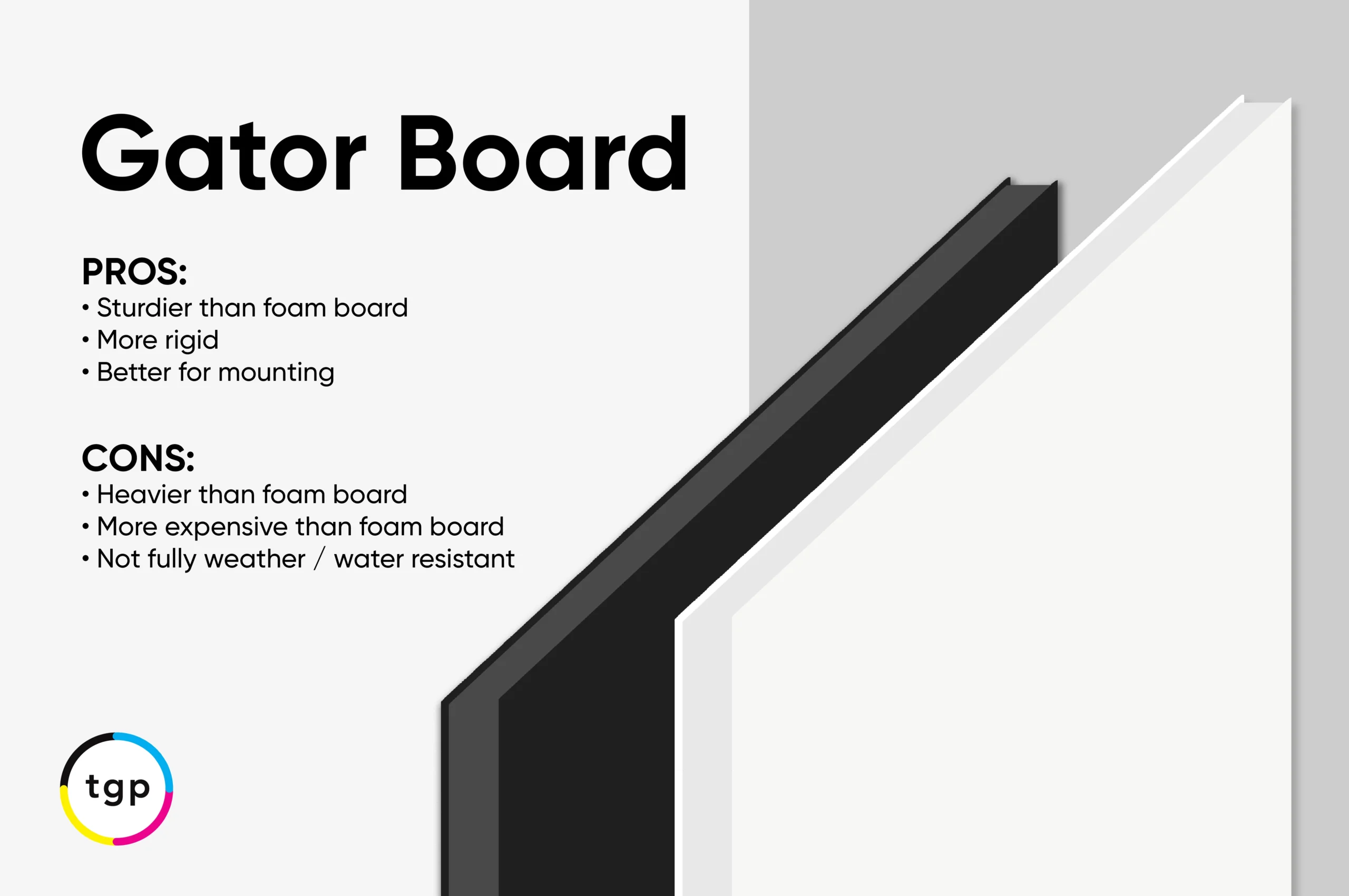
What Is Gator Board Made Of?
Gator Board is made of three main components. Its core consists of lightweight polystyrene foam, which provides the structure and rigidity needed for mounting and displays. The foam core is then encased in two outer layers of dense, wood-fiber veneer.
These wood-fiber surfaces give Gator Board its enhanced durability and smoother, more resilient surface, compared to regular foam board. As a result, it’s popular for long-term use that requires a strong and reliable material, such as interior signage and exhibit displays.
Common Uses For Gator Board Printing
Gatorboard is known for its exceptional durability and rigidity, making it a top choice in commercial printing for projects that require long-lasting and professional-quality results.
Some of the most common uses for commercially printed Gatorboard include:
- Retail Signage: Durable and rigid, perfect for high-end in-store signs, product displays, and promotional signage.
- Exhibition Displays: Sturdy displays for trade shows and exhibitions that can be reused and maintain a professional look over time.
- Point-of-Purchase (POP) Displays: Eye-catching displays that showcase featured products in retail environments.
- Architectural Presentations: High-quality presentation boards that require a durable, professional finish for client meetings.
- Corporate Branding: Ideal for producing long-lasting logo displays, mission statements, and other branded office decor.
What Is Sintra Board?
Sintra Board is a highly durable material made from PVC (polyvinyl chloride), widely used in the signage, printing, and display industries. Its strength, weather resistance, and smooth surface make it a go-to choice for both indoor and outdoor use.
One of the key advantages of Sintra Board is its excellent durability and impact resistance. It’s also lightweight and easy to cut or shape, making it perfect for custom designs and large-format projects. Unlike foam board, Sintra Board is waterproof and ideal for long-term outdoor signage, promotional displays, and point-of-purchase displays.
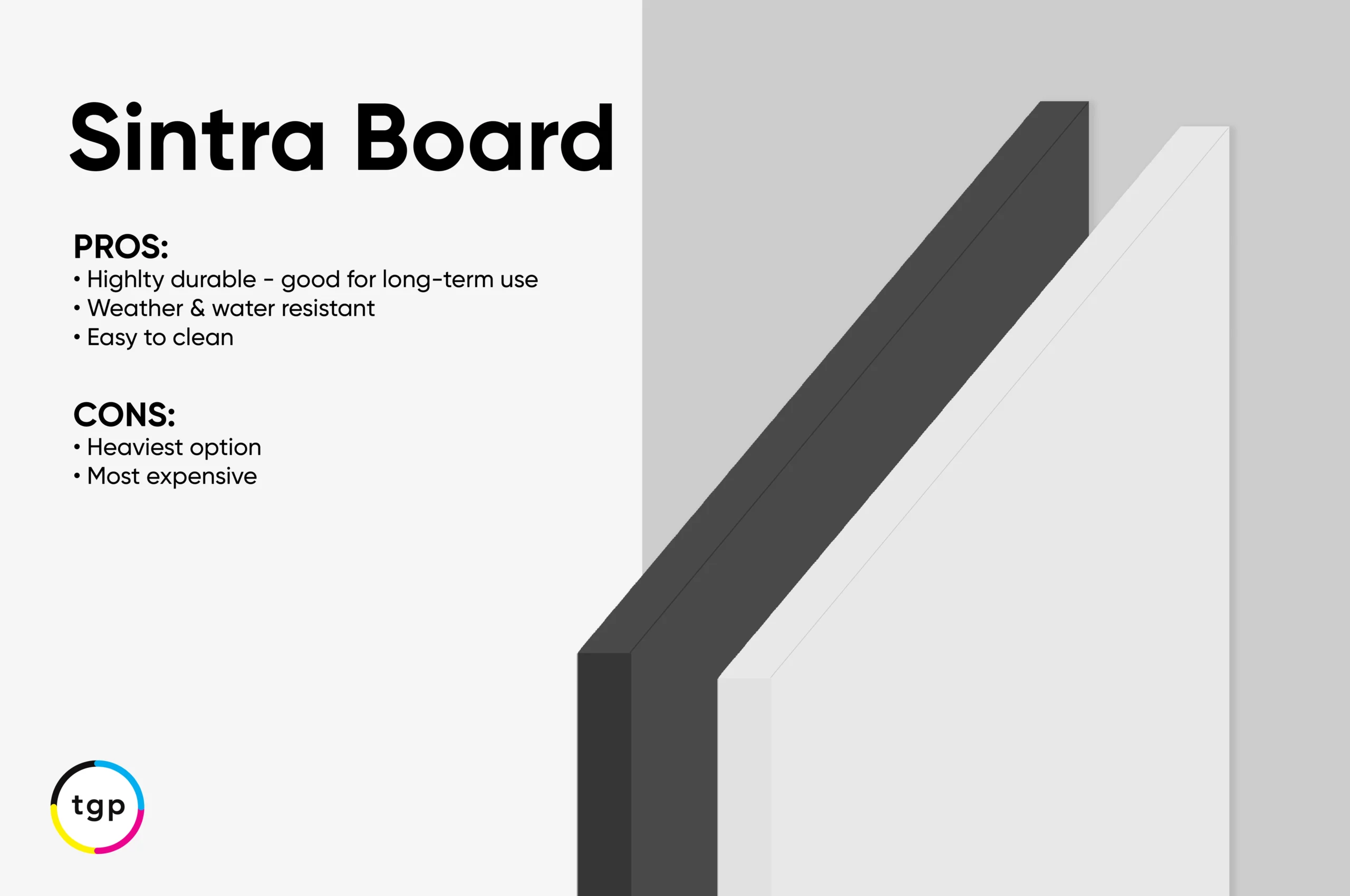
What is Sintra Board Made of?
Sintra board is made of a lightweight yet rigid material called PVC (polyvinyl chloride). It consists of a solid plastic core, which gives it strength and durability. The PVC material is weather-resistant, water-resistant, and resistant to warping or denting, making it ideal for both indoor and outdoor displays.
Common Uses For Sintra Board Printing
Sintra Board is a versatile and highly durable material, ideal for both indoor and outdoor use. Its weather-resistant properties and ease of customization make it a preferred choice in commercial printing.
Commercially printed Sintra Board is commonly used for:
- Outdoor Signage: Weather-resistant signs for storefronts, building exteriors, and outdoor events that require long-term durability.
- Permanent Displays: Long-term use indoors and outdoors, where durability and appearance are crucial.
- Real Estate Signage: Weatherproof signs for open houses, property listings, and other outdoor real estate marketing.
- Menu Boards: In outdoor or high-moisture environments, menu boards need to be durable, waterproof, and easy to clean.
- Corporate Branding: High-quality indoor and outdoor branding elements, such as logo displays and mission statements.
- Event Signage: For both indoor and outdoor events, a professional appearance even in challenging conditions.
What Makes Sintra PVC Board So Unique?
Sintra board stands out among other foam board options because it combines durability, versatility, and lightweight structure. It’s a popular choice for outdoor signage and display projects.
Sintra board is tough and resistant to impacts, scratches, and dents. Its solid PVC structure allows it to maintain its shape over time, even when exposed to harsh conditions.
Those harsh conditions can also include water, humidity, and UV rays – all of which Sintra can resist. Unlike many materials, it won’t warp, swell, or fade when exposed to elements, giving it a long lifespan for outdoor signage.
Despite its impressive durability, Sintra board is very lightweight. This makes it easy to transport, mount, and handle without requiring heavy-duty support systems, a key advantage for both small and large display projects.
Finally, when compared to other rigid materials with similar durability, Sintra board is relatively affordable. It offers an excellent balance of performance and cost, making it a budget-friendly option for high-quality displays.
Is Sintra Board Waterproof?
Yes, Sintra Board is waterproof; it’s made from expanded PVC material, which gives it excellent resistance to moisture and water.
What Is The Difference Between Foam Board And Gator Board?
Gator board and foam board are both popular materials for mounting, signage, and displays, but they differ in terms of strength, durability, and specific applications. Here’s a side-by-side comparison:
| Foam Board | Gator Board | |
| Durability | Lightweight, dents and bends easily | Extremely durable, resists dents and warping |
| Best Use | Short-term, indoor displays | Long-term, professional displays, indoor and some outdoor use |
| Material Composition | Smooth, paper outer layer | Rigid, dense wood-fiber veneer |
| Moisture Resistance | Low, not water-resistant | Higher moisture resistance, though not fully waterproof |
| Weight | Very lightweight | Heavier, sturdier |
Foam Board is best for temporary, lightweight indoor projects, while Gator Board is ideal for professional, long-term displays that require extra strength and resistance to wear and tear.
What Is The Difference Between Foam Board And PVC Foam Board (Sintra)?
Foam board and PVC foam board are both popular materials used for signage, displays, and mounting, but they differ in terms of material composition, durability, and use. Here’s a breakdown of the key differences:
| Foam Board | PVC Foam Board (Sintra) | |
| Durability | Lightweight, dents easily | Durable, weather-resistant |
| Best Use | Short-term, indoor projects | Long-term, indoor/outdoor use |
| Material Composition | Smooth, paper outer layer | Solid PVC plastic |
| Moisture Resistance | Low | High |
| Weight | Very lightweight | Heavier, but still relatively light |
Foam board is best for quick, budget-friendly, indoor projects, while PVC foam board (Sintra) is better suited for long-term, durable projects that can withstand both indoor and outdoor conditions.
Sintra Board Vs Gator Board
Sintra board and Gator board are both durable materials used for signage, mounting, and displays, but they differ in many ways. Here’s a breakdown of the key differences:
| Sintra Board | Gator Board | |
| Durability | Highly durable, weather-resistant | Very durable, but less weather-resistant than Sintra |
| Best Use | Long-term indoor and outdoor use | Long-term indoor displays and signage |
| Material Composition | Solid PVC plastic | Rigid polystyrene foam core with wood-fiber veneer |
| Moisture Resistance | Excellent moisture resistance, waterproof | Moderate moisture resistance, but not ideal for wet conditions |
| Weight | Heavier than Gator board, but still lightweight | Lighter, but rigid and sturdy |
Gator Board Vs Foam Board Vs Sintra Board: Price
When it comes to price, each material price varies.
Foam Board is the most affordable, making it ideal for budget-friendly, short-term projects like presentations or temporary signs. However, its low cost reflects its limited durability and indoor-only use.
Gator Board is mid-range in price. While more expensive than foam board, its greater strength makes it a smart investment for long-term displays and signage.
Sintra Board is the most expensive option due to its solid PVC construction and durability. Its higher price is justified by its superior weather resistance and versatility for both indoor and outdoor posting, making it the best choice for long-term, heavy-duty projects.
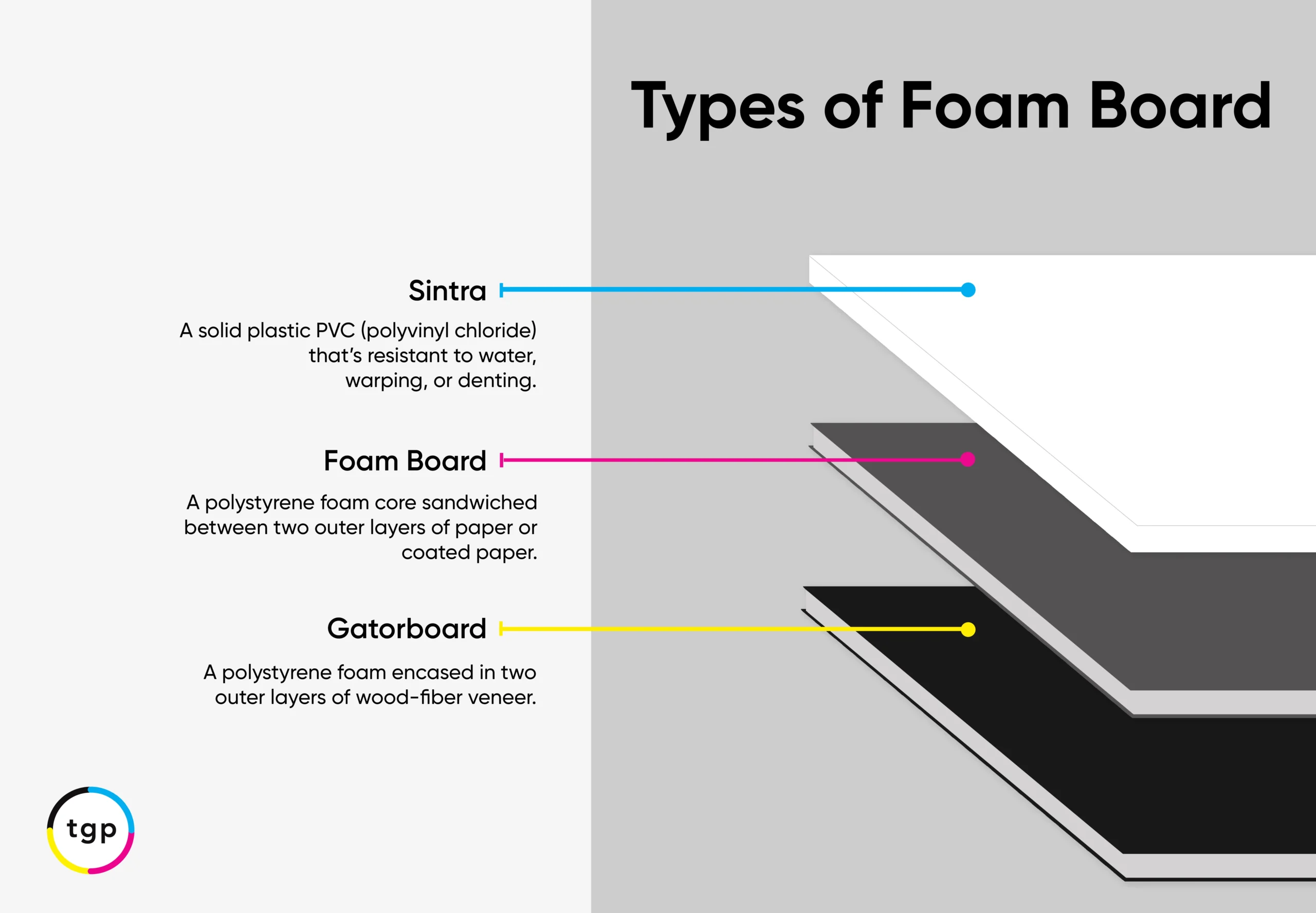
Foam Board Poster Printing With Thomas Group
At Thomas Group, we offer a wide selection of foam board, Gator Board, and Sintra in both white and black, with several thicknesses to choose from. We have the printing options that offer the perfect solution for your unique Foam Board Printing project.
Get in touch now to bring your vision to life with a professional, high-quality finish! Still not quite sure which material is right for your needs? Don’t leave your project to chance, call our team of experts at 212-947-6400. Whether you could use guidance on paper types, design tips, or the printing process, we’re here to help you make the best choice and ensure your project stands out.
